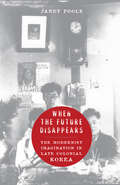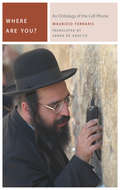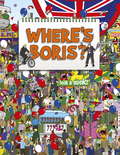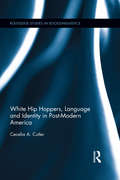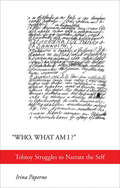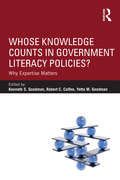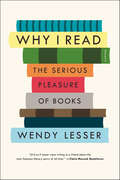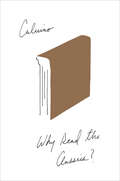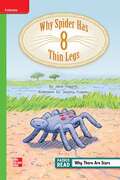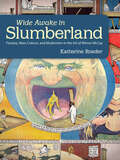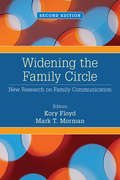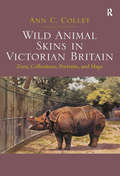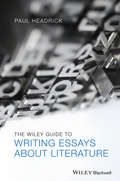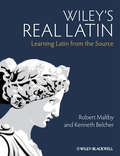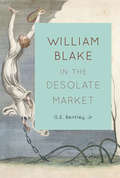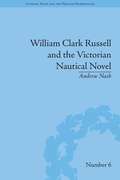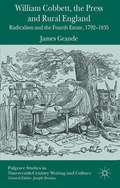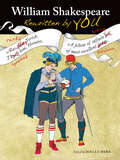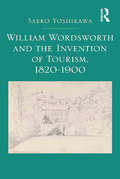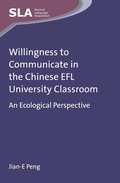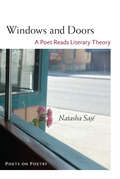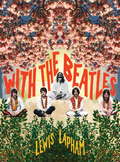- Table View
- List View
When the Future Disappears: The Modernist Imagination in Late Colonial Korea (Studies of the Weatherhead East Asian Institute, Columbia University)
by Janet PooleTaking a panoramic view of Korea's dynamic literary production in the final decade of Japanese rule, When the Future Disappears locates the imprint of a new temporal sense in Korean modernism: the impression of time interrupted, with no promise of a future. As colonial subjects of an empire headed toward total war, Korean writers in this global fascist moment produced some of the most sophisticated writings of twentieth-century modernism.Yi T'aejun, Ch'oe Myongik, Im Hwa, So Insik, Ch'oe Chaeso, Pak T'aewon, Kim Namch'on, and O Changhwan, among other Korean writers, lived through a rare colonial history in which their vernacular language was first inducted into the modern, only to be shut out again through the violence of state power. The colonial suppression of Korean-language publications was an effort to mobilize toward war, and it forced Korean writers to face the loss of their letters and devise new, creative forms of expression. Their remarkable struggle reflects the stark foreclosure at the heart of the modern colonial experience. Straddling cultural, intellectual, and literary history, this book maps the different strategies, including abstraction, irony, paradox, and even silence, that Korean writers used to narrate life within the Japanese empire.
Where Are You?: An Ontology of the Cell Phone
by Umberto Eco Sarah De Sanctis Maurizio FerrarisThis book sheds light on the most philosophically interesting of contemporary objects: the cell phone. “Where are you?”—a question asked over cell phones myriad times each day—is arguably the most philosophical question of our age, given the transformation of presence the cell phone has wrought in contemporary social life and public space. Throughout all public spaces, cell phones are now a ubiquitous prosthesis of what Descartes and Hegel once considered the absolute tool: the hand. Their power comes in part from their ability to move about with us—they are like a computer, but we can carry them with us at all times—in part from what they attach to us (and how), as all that computational and connective power becomes both handy and hand-sized. Quite surprisingly, despite their name, one might argue, as Ferraris does, that cell phones are not really all that good for sound and speaking. Instead, the main philosophical point of this book is that mobile phones have come into their own as writing machines—they function best for text messages, e-mail, and archives of all kinds. Their philosophical urgency lies in the manner in which they carry us from the effects of voice over into reliance upon the written traces that are, Ferraris argues, the basic stuff of human culture. Ontology is the study of what there is, and what there is in our age is a huge network of documents, papers, and texts of all kinds. Social reality is not constructed by collective intentionality; rather, it is made up of inscribed acts. As Derrida already prophesized, our world revolves around writing. Cell phones have attached writing to our fingers and dragged it into public spaces in a new way. This is why, with their power to obliterate or morph presence and replace voice with writing, the cell phone is such a philosophically interesting object.
Where's Boris?
by VariousSearch for Boris Johnson in this eye-boggling illustrated adventure!Greetings citizens! Can you spot Boris?In an array of crowded scenes, from zip wires and bikes to Beijing and the Bullingdon Club, search for Boris amongst the masses. Anyone for wiff-waff?With oodles of in-jokes and bonus material to find, plus cameo appearances from some old chums, this book provides hours of fun for both the lovers and loathers of the blonde-mop-topped phenomenon that is... BoJo.A classic and fun gift book, tracking Boris down around the world will be endless amusement for all the family.
White Hip Hoppers, Language and Identity in Post-Modern America: White Hip-hoppers, Language And Identity In Post-modern America (Routledge Studies in Sociolinguistics #8)
by Cecelia CutlerThis book examines language and identity among White American middle and upper-middle class youth who affiliate with Hip Hop culture. Hip Hop youth engage in practices that range from the consumption of rap music and fashion to practices like MC-ing (writing and performing raps or "rhymes"), DJ-ing (mixing records to produce a beat for the MC), graffiti tagging, and break-dancing. Cutler explores the way in which these young people stylize their speech using linguistic resources drawn from African American English and Hip Hop slang terms. She also looks at the way they construct their identities in discussions with their friends, and how they talk about and use language to construct themselves as authentic within Hip Hop. Cutler considers the possibility that young people experimenting with AAVE-styled speech may improve the status of AAVE in the broader society. She also addresses the need for educators to be aware of the linguistic patterns found in AAVE and Hip Hop language, and ways to build on Hip Hop skills like rhyming and rapping in order to motivate students and promote literacy.
"Who, What Am I?": Tolstoy Struggles to Narrate the Self
by Irina Paperno"God only knows how many diverse, captivating impressions and thoughts evoked by these impressions . . . pass in a single day. If it were only possible to render them in such a way that I could easily read myself and that others could read me as I do. . ." Such was the desire of the young Tolstoy. Although he knew that this narrative utopia—turning the totality of his life into a book—would remain unfulfilled, Tolstoy would spend the rest of his life attempting to achieve it. "Who, What Am I?" is an account of Tolstoy's lifelong attempt to find adequate ways to represent the self, to probe its limits and, ultimately, to arrive at an identity not based on the bodily self and its accumulated life experience. This book guides readers through the voluminous, highly personal nonfiction writings that Tolstoy produced from the 1850s until his death in 1910. The variety of these texts is enormous, including diaries, religious tracts, personal confessions, letters, autobiographical fragments, and the meticulous accounts of dreams. For Tolstoy, inherent in the structure of the narrative form was a conception of life that accorded linear temporal order a predominant role, and this implied finitude. He refused to accept that human life stopped with death and that the self was limited to what could be remembered and told. In short, his was a philosophical and religious quest, and he followed in the footsteps of many, from Plato and Augustine to Rousseau and Schopenhauer. In reconstructing Tolstoy's struggles, this book reflects on the problems of self and narrative as well as provides an intellectual and psychological biography of the writer.
Whose Knowledge Counts in Government Literacy Policies?: Why Expertise Matters
by Robert C. Calfee Kenneth S. Goodman Yetta M. GoodmanAccountability, in the form of standardized test scores, is built into many government literacy policies, with severe consequences for schools and districts that fail to meet ever-increasing performance levels. The key question this book addresses is whose knowledge is considered in framing government literacy policies? The intent is to raise awareness of the degree to which expertise is being ignored on a worldwide level and pseudo-science is becoming the basis for literacy policies and laws. The authors, all leading researchers from the U.S., U.K., Scotland, France, and Germany, have a wide range of views but share in common a deep concern about the lack of respect for knowledge among policy makers. Each author comes to the common subject of this volume from the vantage point of his or her major interests, ranging from an exposition of what should be the best knowledge utilized in an aspect of literacy education policy, to how political decisions are impacting literacy policy, to laying out the history of events in their own country. Collectively they offer a critical analysis of the condition of literacy education past and present and suggest alternative courses of action for the future.
Why I Read: The Serious Pleasure of Books
by Wendy Lesser"Wendy Lesser's extraordinary alertness, intelligence, and curiosity have made her one of America's most significant cultural critics," writes Stephen Greenblatt. In Why I Read, Lesser draws on a lifetime of pleasure reading and decades of editing one of the most distinguished literary magazines in the country, The Threepenny Review, to describe her love of literature. As Lesser writes in her prologue, "Reading can result in boredom or transcendence, rage or enthusiasm, depression or hilarity, empathy or contempt, depending on who you are and what the book is and how your life is shaping up at the moment you encounter it." Here the reader will discover a definition of literature that is as broad as it is broad-minded. In addition to novels and stories, Lesser explores plays, poems, and essays along with mysteries, science fiction, and memoirs. As she examines these works from such perspectives as "Character and Plot," "Novelty," "Grandeur and Intimacy," and "Authority," Why I Read sparks an overwhelming desire to put aside quotidian tasks in favor of reading. Lesser's passion for this pursuit resonates on every page, whether she is discussing the book as a physical object or a particular work's influence. "Reading literature is a way of reaching back to something bigger and older and different," she writes. "It can give you the feeling that you belong to the past as well as the present, and it can help you realize that your present will someday be someone else's past. This may be disheartening, but it can also be strangely consoling at times." A book in the spirit of E. M. Forster's Aspects of the Novel and Elizabeth Hardwick's A View of My Own, Why I Read is iconoclastic, conversational, and full of insight. It will delight those who are already avid readers as well as neophytes in search of sheer literary fun.
Why Read the Classics? (Penguin Modern Classics Ser.)
by Italo CalvinoThis collection of essays by the acclaimed author of Cosmicomics offers a fascinating, personal journey through some of literature&’s greatest works. Classics, according to Italo Calvino, are not only works of enduring cultural value, but also personal touchstones. They are the books we are always rereading in order to understand our world and ourselves. Here, Calvino introduces more than thirty works from his own ideal library in essays of warmth, humor, and striking insight. He discusses great authors ranging from Homer to Jorge Luis Borges, and from Charles Dickens to the Persian folklorist Nezami. Whether tracing the links between Ovid&’s Metamorphoses and Alain Robbe-Grillet&’s objectivity, discovering the origins of science fiction in the writings of Cyrano de Bergerac, or convincing us that the Italian novelist Carlo Emilio Gadda&’s works are like artichokes, Calvino offers a new perspective on beloved favorites and introduces us to hidden gems. &“This book serves as a welcome reminder that the great works are great because they can mean so much to readers, and Calvino is a most knowledgeable guide to all the best destinations.&”—San Francisco Chronicle
Wide Awake in Slumberland: Fantasy, Mass Culture, and Modernism in the Art of Winsor McCay (Tom Inge Series on Comics Artists)
by Katherine RoederCartoonist Winsor McCay (1869-1934) is rightfully celebrated for the skillful draftmanship and inventive design sense he displayed in the comic strips Little Nemo in Slumberland and Dream of the Rarebit Fiend. McCay crafted narratives of anticipation, abundance, and unfulfilled longing. This book explores McCay's interest in dream imagery in relation to the larger preoccupation with fantasy that dominated the popular culture of early twentieth-century urban America. McCay's role as a pioneer of early comics has been documented; yet, no existing study approaches him and his work from an art historical perspective, giving close readings of individual artworks while situating his output within the larger visual culture and the rise of modernism. From circus posters and vaudeville skits to department store window displays and amusement park rides, McCay found fantastical inspiration in New York City's burgeoning entertainment and retail districts. Wide Awake in Slumberland connects McCay's work to relevant children's literature, advertising, architecture, and motion pictures in order to demonstrate the artist's sophisticated blending and remixing of multiple forms from mass culture. Studying this interconnection in McCay's work and, by extension, the work of other early twentieth-century cartoonists, Roeder traces the web of relationships connecting fantasy, leisure, and consumption. Readings of McCay's drawings and the eighty-one black-and-white and color illustrations reveal a man who was both a ready participant and an incisive critic of the rising culture of fantasy and consumerism.
Widening the Family Circle: New Research on Family Communication
by Dr Kory W. Floyd Dr Mark T. MormanWidening the Family Circle: New Research on Family Communication, Second Edition continues to address historically under-studied family relationships, such as those involving grandparents, in-laws, cousins, stepfamilies, and adoptive parents. In this engaging text, editors Kory Floyd and Mark T. Morman bring together a diverse collection of empirical studies, theoretic essays, and critical reviews of literature on communication to constitute a stronger, more complete understanding of communication within the family.
Wild Animal Skins in Victorian Britain: Zoos, Collections, Portraits, and Maps
by Ann C. ColleyWhat did the 13th Earl of Derby, his twenty-two-year-old niece, Manchester’s Belle Vue Zoo, and even some ordinary laborers all have in common? All were avid collectors and exhibitors of exotic, and frequently unruly, specimens. In her study of Britain’s craze for natural history collecting, Ann C. Colley makes extensive use of archival materials to examine the challenges, preoccupations, and disordered circumstances that attended the amassing of specimens from faraway places only vaguely known to the British public. As scientific institutions sent collectors to bring back exotic animals and birds for study and classification by anatomists and zoologist, it soon became apparent that collecting skins rather than live animals or birds was a relatively more manageable endeavor. Colley looks at the collecting, exhibiting, and portraying of animal skins to show their importance as trophies of empire and representations of identity. While a zoo might display skins to promote and glorify Britain’s colonial achievements, Colley suggests that the reality of collecting was characterized more by chaos than imperial order. For example, Edward Lear’s commissioned illustrations of the Earl of Derby’s extensive collection challenge the colonial’s or collector’s commanding gaze, while the Victorian public demonstrated a yearning to connect with their own wildness by touching the skins of animals. Colley concludes with a discussion of the metaphorical uses of wild skins by Gerard Manley Hopkins and other writers, exploring the idea of skin as a locus of memory and touch where one’s past can be traced in the same way that nineteenth-century mapmakers charted a landscape. Throughout the book Colley calls upon recent theories about the nature and function of skin and touch to structure her discussion of the Victorian fascination with wild animal skins.
The Wiley Blackwell Anthology of African American Literature, Volume 1: 1746 - 1920 (Blackwell Anthologies)
by Gene Andrew JarrettThe Wiley Blackwell Anthology of African American Literature is a comprehensive collection of poems, short stories, novellas, novels, plays, autobiographies, and essays authored by African Americans from the eighteenth century until the present. Evenly divided into two volumes, it is also the first such anthology to be conceived and published for both classroom and online education in the new millennium. Reflects the current scholarly and pedagogic structure of African American literary studies Selects literary texts according to extensive research on classroom adoptions, scholarship, and the expert opinions of leading professors Organizes literary texts according to more appropriate periods of literary history, dividing them into seven sections that accurately depict intellectual, cultural, and political movements Includes more reprints of entire works and longer selections of major works than any other anthology of its kind This first volume contains a comprehensive collection of texts authored by African Americans from the eighteenth century until the 1920s The two volumes of this landmark anthology can also be bought as a set, at over 20% savings.
The Wiley Blackwell Anthology of African American Literature, Volume 2: 1920 to the Present (Blackwell Anthologies)
by Gene Andrew JarrettThe Wiley Blackwell Anthology of African American Literature is a comprehensive collection of poems, short stories, novellas, novels, plays, autobiographies, and essays authored by African Americans from the eighteenth century until the present. Evenly divided into two volumes, it is also the first such anthology to be conceived and published for both classroom and online education in the new millennium. Reflects the current scholarly and pedagogic structure of African American literary studies Selects literary texts according to extensive research on classroom adoptions, scholarship, and the expert opinions of leading professors Organizes literary texts according to more appropriate periods of literary history, dividing them into seven sections that accurately depict intellectual, cultural, and political movements Includes more reprints of entire works and longer selections of major works than any other anthology of its kind This second volume contains a comprehensive collection of texts authored by African Americans from the 1920s to the present The two volumes of this landmark anthology can also be bought as a set, at over 20% savings.
The Wiley Guide to Writing Essays About Literature
by Paul HeadrickThis outstanding practical guide to writing analytical essays on literature develops interpretive skills through focused exercises and modeled examples. The program is tailored to meet the specific needs of beginning undergraduates.Features unique, detailed guidance on paragraph structureIncludes sample essays throughout to model each stage of the essay-writing processFocused exercises develop the techniques outlined in each chapterDedicated checklists enable quick, accurate assessment by teachers and studentsEnhanced glossary with advice on usage added to core definitions
Wiley's Real Latin
by Robert Maltby Kenneth BelcherThis innovative guide to the Latin language, written for a new generation of students, deploys examples and translation exercises taken exclusively from the Classical Latin canon.Translation exercises use real Latin from a variety of sources, including political speeches, letters, history, poetry, and plays, and from a range of authors, including Julius Caesar, Cicero, Virgil, Catullus, Ovid, and Plautus, among othersOffers a variety of engaging, informative pedagogical features to help students practice and contextualize lessons in the main narrativePrepares students for immersion in the great works of Classical Latin literatureA companion website provides additional exercises and drills for students and teachers
William Blake in the Desolate Market
by G.E. Bentley JrExperience taught William Blake that "Wisdom is sold in the desolate market where none come to buy." His brilliant achievements as a poet, painter, and engraver brought him public notice, but little income. William Blake in the Desolate Market records how Blake, the most original of all the major English poets, earned his living. G.E. Bentley Jr, the dean of Blake scholars, details the poet's occupations as a commercial engraver, print-seller, teacher, copperplate printer, painter, publisher, and vendor of his own books. In his early career as a commercial engraver, Blake was modestly prosperous, but thereafter his fortunes declined. For his most ambitious commercial designs, he made hundreds of folio designs and scores of engravings, but was paid scarcely more than twenty pounds for two or three years' work. His invention of illuminated printing lost money, and many of his greatest works, such as Jerusalem, were left unsold at his death. He came to believe that his "business is not to gather gold, but to make glorious shapes." William Blake in the Desolate Market is an investigation of Blake's labours to support himself by his arts. The changing prices of his works, his costs and receipts, as well as his patrons and employers are expertly gathered and displayed to show the material side of the artistic career in Britain's Romantic period.
William Clark Russell and the Victorian Nautical Novel: Gender, Genre and the Marketplace (Literary Texts and the Popular Marketplace #6)
by Andrew NashWilliam Clark Russell wrote more than forty nautical novels. Immensely popular in their time, his works were admired by contemporary writers, such as Conan Doyle, Stevenson and Meredith, while Swinburne, considered him 'the greatest master of the sea, living or dead'. Based on extensive archival research, Nash explores this remarkable career.
William Cobbett, the Press and Rural England
by James GrandeWilliam Cobbett, the Press and Rural England offers a thorough re-appraisal of the work of William Cobbett (1763-1835), examining his pioneering journalism, identification with rural England and engagement with contemporary debates. It offers a new interpretation of Cobbett as a Burkean radical, whose work cuts across the 'revolution controversy' of the 1790s and combines Tom Paine's common sense and transatlantic radicalism with Edmund Burke's emphasis on tradition, patriotism and the domestic affections. To Hazlitt, Cobbett came to represent 'a kind of fourthestate in the politics of the country', becoming the virtual embodiment of both rural England and the campaign for parliamentary reform. This study draws on Cobbett's published writings and unpublished correspondence to show how he achieved this status. Individual chapters focus on his writings as Peter Porcupine, publication of parliamentary debates, imprisonment in Newgate, exile on Long Island, role in the Queen Caroline affair, Rural Rides, his prosecution after the Captain Swing riots and his wide-ranging legacies.
William Shakespeare Rewritten by You
by Joelle HerrREWRITE THE BARD'S WORDS FOR IRREVERENT FUN AND LITERARY LAUGHSDo you want to have some fun with Shakespeare?Rip the quill from the Bard's immortal hands and pen hilarious versions of the most-beloved scenes from:HamletTo be STRIP, or not to be STRIP, that is the question. Romeo and JulietWhat light FART through yonder window breaks?MacbethIs this a dagger JOINT which I see before me?Much Ado About NothingIf thou dost love BOFF, my kindness VIBRATOR shall incite theeA Midsummer Night's Dream So, good night unto you all.Give FEED me your hands BRAINS ,if we be friends,And Robin YOUR MOMMA shall restore amends. AND MORE!
William Wordsworth and the Invention of Tourism, 1820-1900
by Saeko YoshikawaIn her study of the opening of the English Lake District to mass tourism, Saeko Yoshikawa examines William Wordsworth’s role in the rise and development of the region as a popular destination. For the middle classes on holiday, guidebooks not only offered practical information, but they also provided a fresh motive and a new model of appreciation by associating writers with places. The nineteenth century saw the invention of Robert Burns’s and Walter Scott’s Borders, Shakespeare’s Stratford, and the Brontë Country as holiday locales for the middle classes. Investigating the international cult of Wordsworthian tourism, Yoshikawa shows both how Wordsworth’s public celebrity was constructed through the tourist industry and how the cultural identity of the Lake District was influenced by the poet’s presence and works. Informed by extensive archival work, her book provides an original case study of the contributions of Romantic writers to the invention of middle-class tourism and the part guidebooks played in promoting the popular reputations of authors.
Willingness to Communicate in the Chinese EFL University Classroom
by Jian-E PengThis book presents mixed-methods research into Chinese students' willingness to communicate (WTC) in an EFL classroom context. The interrelationships between WTC and motivation, communication confidence, learner beliefs and classroom environment are examined using structural equation modelling on data collected in a large-scale survey. These results are then complemented and expanded upon in a follow-up multiple case-study that identifies six themes which account for fluctuations of WTC over time and across situations. The qualitative and quantitative data provide the grounds for the proposition of an ecological model of WTC in the Chinese EFL university classroom, which reveals that WTC is socioculturally constructed as a function of the interaction of individual and environmental factors inside and beyond the classroom walls.
Windows and Doors: A Poet Reads Literary Theory
by Natasha SajeWindows and Doors is a poetry handbook that places poststructuralist and postmodern ways of thinking alongside formalist modes, making explicit points of overlap and tension that are usually tacit. Each of Natasha Sajé's nine essays addresses a topic of central concern to readers and writers of poetry while also making an argument about poetic language and ideology. Foundational topics--diction, syntax, rhythm, surprise, figurative language, narrative, genre, book design, and performance--are explained through the lenses of theory, history, and philosophy and illuminated through vibrant examples from the works of numerous contemporary American poets.
With the Beatles
by Lewis LaphamHalfway between the summer of love and the Tet offensive, the Beatles went to India to study with the Maharishi--and Lewis Lapham, esteemed Harper's editor and award-winning writer, was there. WITH THE BEATLES is a remarkable book of cultural commentary on that seminal '60s moment.The ashram in Rishikesh, India was the ultimate '60s scene: the Beatles, Donovan, Mia Farrow, a stray Beach Boy and other '60s icons gathered along the shores of the Ganges--amidst paisley and incense and flowers and guitars--to meditate at the feet of the Maharishi Mahesh Yogi. The February 1968 gathering received such frenzied, world-wide attention that it is still considered a significant, early encounter between Western pop culture and the mystical East. And Lewis Lapham was the only journalist allowed inside.And what went on inside the compound has long been the subject of wild speculation and rampant rumor. The Beatles said they wrote some of their greatest songs there . . . and yet they also came away bitterly disillusioned. In WITH THE BEATLES, Lewis Lapham finally tells the whole story.
